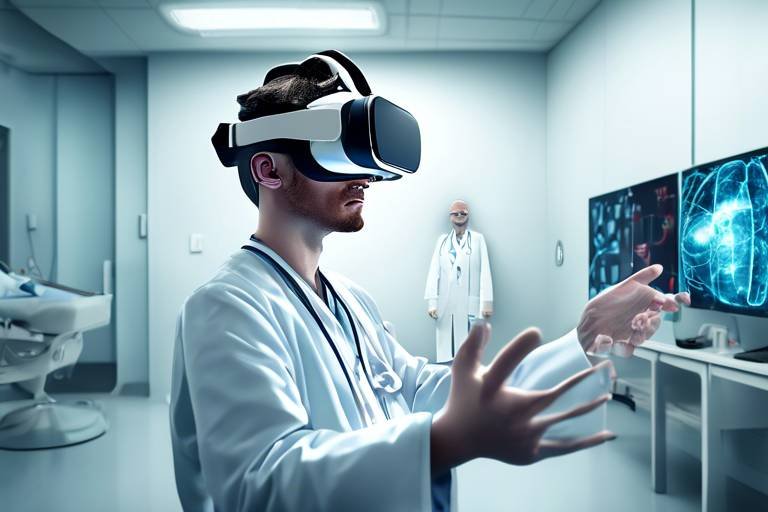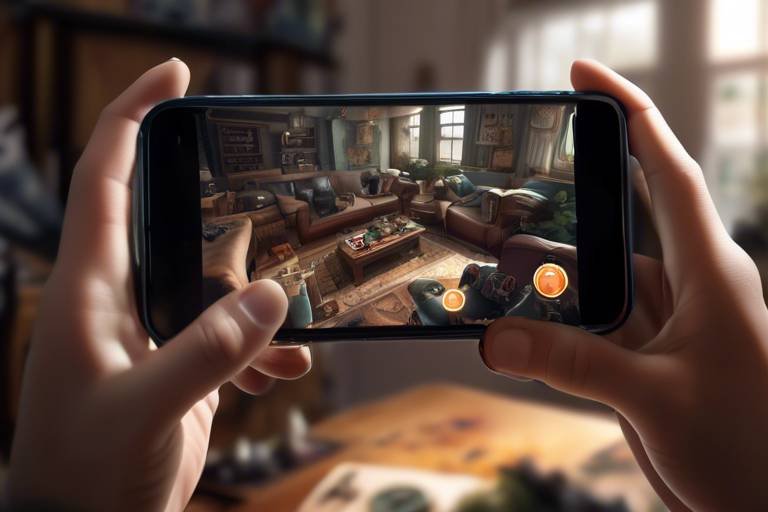Virtual Reality in Healthcare: How VR Is Changing Medicine?
Virtual reality (VR) is not just a tool for gaming or entertainment; it has emerged as a groundbreaking technology that is transforming the healthcare landscape. Imagine stepping into a world where medical professionals can practice complex surgeries without any risk, or where patients can manage their pain through immersive experiences that take them far away from their discomfort. This is the reality that VR brings to the table, and it’s changing medicine in ways we never thought possible.
At its core, VR offers a unique opportunity to simulate real-life scenarios in a controlled environment. This means that medical students can engage in lifelike simulations that enhance their learning experience, while patients can be treated through innovative therapies that distract them from pain or anxiety. The applications of VR in healthcare are vast and varied, and they all point towards a future where patient care is more effective and engaging.
One of the most exciting aspects of VR in healthcare is its ability to enhance medical training. Traditional methods of teaching often rely on textbooks and lectures, which can be dry and uninspiring. With VR, students can dive into an interactive learning experience that allows them to practice procedures and hone their skills in a safe space. Imagine a budding surgeon practicing a complex operation on a virtual patient, gaining confidence and expertise without the pressure of real-life consequences. This immersive approach not only makes learning more enjoyable but also significantly improves skill retention.
But VR isn't just for training; it's also making waves in pain management. Patients suffering from chronic pain or undergoing procedures can benefit from VR as a non-pharmacological approach to pain relief. By immersing themselves in a captivating virtual environment, they can distract their minds from discomfort, leading to a more manageable experience. This innovative method is reshaping how we think about pain management, providing a more holistic approach to treatment.
Moreover, VR is proving to be invaluable in therapeutic settings. From mental health treatments that help patients confront their fears to rehabilitation programs that motivate individuals to engage in physical therapy, the potential is immense. Therapists can create tailored experiences that support recovery, allowing patients to progress at their own pace while feeling empowered and engaged.
As VR continues to evolve, it also enhances patient engagement. Patients are often overwhelmed with information regarding their conditions and treatment options. However, by utilizing VR, healthcare providers can create interactive experiences that educate patients about their health in an engaging manner. This not only helps patients understand their situations better but also fosters a sense of ownership over their health, leading to improved adherence to treatment plans.
Despite its myriad benefits, integrating VR into healthcare is not without challenges. High costs, technical issues, and the need for specialized training among healthcare professionals can hinder widespread adoption. Additionally, as with any new technology, there are ethical considerations to address, such as patient privacy and informed consent. It’s crucial to navigate these challenges thoughtfully to ensure that VR can be implemented effectively and ethically in healthcare settings.
Looking ahead, the future of VR in healthcare is incredibly promising. With ongoing advancements in technology and increased accessibility, we can expect to see even more innovative applications emerge. From surgical planning and simulation to enhancing patient outcomes, the possibilities are endless. Research indicates that VR can improve recovery rates, reduce anxiety, and elevate patient satisfaction levels, making it a game-changer in the field.
In conclusion, virtual reality is not just a fleeting trend; it is a transformative force in healthcare that is reshaping how we approach medical training, patient care, and therapeutic interventions. As we embrace this technology, we stand on the brink of a new era in medicine—one where the potential for improved patient outcomes and enhanced healthcare experiences is within our reach.
- What is virtual reality in healthcare?
Virtual reality in healthcare refers to the use of immersive technology to simulate real-world medical scenarios for training, treatment, and patient engagement.
- How does VR help in medical training?
VR provides medical students and professionals with realistic simulations to practice procedures, enhancing their skills and confidence in a safe environment.
- Can VR be used for pain management?
Yes, VR is increasingly being used as a non-pharmacological approach to pain management, helping patients manage discomfort through engaging virtual experiences.
- What are the challenges of implementing VR in healthcare?
Challenges include high costs, technical issues, and the need for training among healthcare professionals to effectively use VR technology.
- What does the future hold for VR in healthcare?
The future is bright, with ongoing research and advancements in technology paving the way for more innovative applications and improved patient care.

Applications of VR in Medical Training
Virtual reality (VR) is revolutionizing the landscape of medical education, providing a groundbreaking platform for both students and healthcare professionals to hone their skills in a risk-free environment. Imagine being able to practice complex surgical procedures without the fear of causing harm to a real patient. This immersive technology enables learners to step into a 3D world where they can interact with lifelike simulations, fostering a deeper understanding of anatomy and medical procedures.
One of the key benefits of VR in medical training is the ability to replicate a variety of clinical scenarios. Whether it’s performing a delicate surgery or managing a critical care situation, VR allows trainees to experience high-pressure environments that they might face in real life. This hands-on approach not only boosts their confidence but also enhances their decision-making skills. For instance, a student can practice suturing techniques repeatedly until they achieve mastery, all while receiving real-time feedback from the VR system.
Furthermore, VR training modules can be tailored to meet the specific needs of different medical disciplines. From emergency medicine to surgical training, the adaptability of VR ensures that healthcare professionals can access relevant simulations that align with their career goals. The technology also supports collaborative learning, where multiple users can engage in a shared virtual space, fostering teamwork and communication skills essential for effective patient care.
As we delve deeper into the applications of VR, it’s important to highlight some of the specific areas where this technology is making a significant impact:
- Procedural Training: Trainees can practice complex procedures like laparoscopic surgery or endoscopy in a controlled, virtual environment.
- Anatomical Exploration: VR allows students to explore human anatomy in 3D, offering a more intuitive understanding compared to traditional textbooks.
- Patient Interaction: Role-playing scenarios enable students to practice their bedside manners and communication skills with virtual patients, preparing them for real-world interactions.
Moreover, the integration of virtual reality in medical training is not just about enhancing skills; it’s also about improving retention rates. Studies have shown that immersive learning experiences lead to better information retention compared to conventional learning methods. This means that future healthcare providers are not only learning faster but are also more likely to remember crucial information when it matters most—during patient care.
In conclusion, the applications of VR in medical training are vast and varied, offering a transformative approach to education in the healthcare field. As technology continues to advance, we can expect to see even more innovative uses of VR, making medical training more effective, engaging, and accessible than ever before. The future of medical education is not just in classrooms anymore; it’s in the virtual realm, where the only limit is the imagination of those who dare to explore it.

VR in Pain Management
Imagine this: you're in a hospital, and the thought of the pain you're about to experience is overwhelming. Now, what if I told you that instead of just medication, there’s a whole new world waiting for you? This is where Virtual Reality (VR) steps in as a game-changer in pain management. VR is not just about gaming; it’s about creating immersive experiences that can truly transform how we perceive and handle pain. Through engaging environments and interactive scenarios, patients can find themselves transported away from their discomfort, allowing their minds to focus elsewhere. This distraction technique is proving to be a powerful ally in the fight against pain.
Research has shown that VR can effectively reduce pain perception in various medical settings. For instance, during wound care or physical therapy, patients often experience significant anxiety and discomfort. By immersing them in a calming virtual environment—like a serene beach or a peaceful forest—patients can experience a marked reduction in pain levels. Studies have indicated that patients using VR during painful procedures report lower pain scores compared to those who do not use VR. This phenomenon can be attributed to the brain's ability to redirect focus away from pain through immersive experiences, making it feel less intense.
Moreover, VR can also help in managing chronic pain, which affects millions of people worldwide. Chronic pain can be debilitating, leading to a cycle of anxiety and depression. VR offers a unique solution by enabling patients to engage in therapeutic exercises in a virtual space, which can help them regain control over their bodies and minds. For example, a patient suffering from chronic back pain can participate in a virtual yoga class designed to strengthen their core without the physical strain that might exacerbate their condition.
Here’s a quick breakdown of the benefits of using VR in pain management:
- Distraction: Engaging with a virtual environment diverts attention from pain.
- Reduced Anxiety: Immersive experiences can help alleviate the anxiety that often accompanies pain.
- Enhanced Recovery: Patients may recover faster when they are less focused on their pain.
- Empowerment: Patients can take an active role in their pain management through interactive VR experiences.
However, while the benefits of VR in pain management are evident, it’s essential to recognize that it is not a one-size-fits-all solution. Individual responses to VR can vary, and some patients may find it less effective than others. Additionally, the technology itself can be a barrier; not all healthcare facilities have access to the necessary equipment or expertise to implement VR programs effectively. As we continue to explore the potential of VR in healthcare, it's crucial to remain aware of these challenges while advocating for its integration into pain management protocols.
As we look to the future, the possibilities for VR in pain management are vast. With ongoing advancements in technology, we can expect even more sophisticated and personalized VR experiences tailored to individual patient needs. Imagine a future where VR becomes a standard part of pain management strategies, helping patients navigate their healing journeys with greater ease and less discomfort.
- How does VR help in pain management? VR helps by distracting patients from their pain through immersive experiences, which can lead to reduced pain perception.
- Is VR effective for all types of pain? While many patients experience relief, effectiveness can vary based on individual circumstances and the type of pain.
- Are there any side effects of using VR for pain management? Generally, VR is safe, but some users may experience motion sickness or discomfort while using the headset.
- How can I access VR for pain management? Consult your healthcare provider to see if VR options are available at your treatment facility.

Therapeutic Uses of VR
Virtual reality (VR) is not just a tool for gaming or entertainment; it is making significant strides in the field of therapy. Imagine stepping into a world where your fears, anxieties, and physical ailments can be addressed in a controlled and engaging environment. This is exactly what VR offers, transforming traditional therapeutic practices into immersive experiences that can lead to profound healing. From mental health treatment to physical rehabilitation, VR is opening doors to innovative approaches that were once the stuff of science fiction.
In the realm of mental health, VR has proven to be a game-changer. Therapists are now using VR to help patients confront their fears through exposure therapy. For instance, someone with a fear of heights can don a VR headset and find themselves atop a skyscraper, all while remaining safely on the ground. This safe yet realistic exposure allows patients to gradually desensitize themselves to their fears, leading to significant improvements in anxiety levels. Research has shown that such immersive therapies can lead to faster recovery times and more effective treatment outcomes compared to traditional methods.
Physical therapy is another area where VR shines. Patients recovering from injuries often face the daunting task of performing repetitive exercises that can be tedious and demotivating. VR changes the game by gamifying rehabilitation. Imagine a patient working on their range of motion while navigating through a vibrant virtual world, collecting rewards, and achieving milestones. This not only makes therapy more enjoyable but also encourages greater participation, leading to better recovery rates. Studies suggest that patients using VR in physical therapy show improved engagement and motivation, which directly correlates with their recovery speed.
Furthermore, VR is being utilized in pain management. For those suffering from chronic pain or undergoing painful procedures, VR can provide a much-needed distraction. By immersing patients in calming environments—like serene beaches or lush forests—VR helps to divert their attention away from discomfort. This technique, known as distraction therapy, has been shown to lower pain perception and reduce the need for medication in some cases. The ability to manipulate a patient's sensory experience in real-time opens up new avenues for pain relief that are both effective and non-invasive.
The therapeutic uses of VR extend to cognitive rehabilitation as well. Patients recovering from strokes or traumatic brain injuries can benefit from VR exercises designed to enhance cognitive function and motor skills. These immersive environments can be tailored to the specific needs of the patient, allowing for personalized therapy that adapts as they progress. Such adaptability is crucial, as it keeps patients engaged and motivated, which is often half the battle in recovery.
As we look towards the future, the potential for VR in therapeutic settings is vast. With ongoing advancements in technology, the experiences offered are becoming increasingly realistic and beneficial. The integration of VR into therapeutic practices is not just a passing trend; it represents a significant shift in how we approach healing. By combining technology with empathy and understanding, healthcare professionals are poised to enhance the quality of care and improve patient outcomes like never before.
- What types of therapy can benefit from VR? VR can be used in mental health therapy, physical rehabilitation, pain management, and cognitive rehabilitation.
- Is VR therapy safe? Yes, when conducted under the supervision of a trained professional, VR therapy is considered safe and effective.
- How does VR help with pain management? VR provides immersive experiences that distract patients from pain, reducing their perception of discomfort.
- Can VR be used for all patients? While VR is beneficial for many, it may not be suitable for everyone. A healthcare professional can determine its appropriateness.

Enhancing Patient Engagement
In today's fast-paced medical environment, patient engagement has become a crucial factor in achieving better health outcomes. Virtual reality (VR) is stepping up to the plate, offering innovative ways to captivate patients and involve them actively in their healthcare journey. Imagine walking into a doctor's office and being greeted not just by a friendly face, but by a virtual world that explains your condition in vivid detail. How cool is that? With VR, patients can visualize their health issues, understand treatment options, and even participate in simulations that demystify complex procedures.
One of the most exciting aspects of VR is its ability to create immersive experiences that educate patients. Instead of simply reading pamphlets or listening to long explanations, patients can don a VR headset and step into a 3D environment where they can interact with their health information. This not only makes learning more engaging but also ensures that patients retain important information. Studies have shown that when patients are actively involved in their care, they are more likely to follow treatment plans and make healthier choices.
Moreover, VR can be tailored to meet the unique needs of different patients. For instance, children can explore a fun, animated world that explains their medical procedures in a way that feels less intimidating. On the other hand, adults might benefit from realistic simulations that allow them to visualize surgical procedures or rehabilitation exercises. This personalization enhances the patient experience and builds trust between healthcare providers and patients.
But how does VR actually enhance engagement? Here are a few key ways:
- Interactive Learning: Patients can participate in interactive sessions that allow them to ask questions and receive immediate feedback.
- Visual Understanding: Complex medical concepts become clearer when patients can see them in action, helping to eliminate confusion.
- Emotional Connection: Immersive experiences can evoke emotions, making patients feel more connected to their health journey.
As we look to the future, the potential of VR in enhancing patient engagement is limitless. Healthcare providers are beginning to recognize the importance of patient-centered care, and VR is a powerful tool that can help bridge the gap between medical professionals and patients. By creating environments where patients feel informed, empowered, and engaged, VR is not just changing how we approach healthcare; it's revolutionizing it.
In conclusion, the integration of virtual reality into healthcare practices is paving the way for a more informed and engaged patient population. As technology continues to advance, we can expect even more innovative applications of VR that will transform the patient experience and lead to improved health outcomes.
- What is virtual reality in healthcare? Virtual reality in healthcare refers to the use of immersive technology to enhance patient education, engagement, and treatment experiences.
- How can VR improve patient understanding of medical procedures? VR allows patients to visualize and interact with their treatment plans, making complex procedures easier to understand.
- Is VR effective for all types of patients? Yes, VR can be tailored to suit various age groups and medical conditions, making it a versatile tool for patient engagement.
- What are the costs associated with implementing VR in healthcare? While initial setup costs can be high, the long-term benefits of improved patient outcomes and satisfaction can outweigh these expenses.

Challenges in Implementing VR in Healthcare
While the potential of Virtual Reality (VR) in healthcare is nothing short of revolutionary, its implementation is not without significant challenges. One of the most pressing issues is the high cost associated with VR technology. From the initial investment in hardware and software to ongoing maintenance and updates, the financial burden can be daunting for healthcare facilities, especially smaller practices. Imagine a small clinic trying to allocate its already limited budget to incorporate cutting-edge technology like VR. It’s a tough sell.
Moreover, there are technical issues that can arise during the integration of VR systems. These can range from software glitches to hardware malfunctions, which can disrupt the training or treatment process. For instance, if a VR system crashes during a training session for medical students, it not only wastes valuable time but can also hinder the learning experience. The healthcare sector is already burdened with numerous technological challenges, and adding VR into the mix can complicate matters further.
Another considerable challenge is the need for training among healthcare professionals. Just having the technology is not enough; staff must be adequately trained to use these systems effectively. This requires time and resources that many healthcare providers may not have readily available. Think about it: a surgeon or a nurse already has a packed schedule. Adding VR training to their workload can feel overwhelming, and without proper training, the technology can be underutilized or misused.
Furthermore, there are concerns about patient acceptance. Not all patients are comfortable with using VR technology, particularly older adults who may not be as tech-savvy. They might find the headsets intimidating or simply prefer traditional methods of treatment. This can create a barrier to the widespread adoption of VR in clinical settings. To overcome this, healthcare providers need to educate patients about the benefits and ease of use of VR, but that requires additional time and effort.
Lastly, there are ethical considerations that need to be addressed. Issues such as patient privacy and informed consent become even more critical in a VR environment. How do we ensure that patient data collected during VR sessions is kept secure? What measures are in place to ensure that patients fully understand what they are consenting to when engaging with VR technology? These are vital questions that healthcare providers must grapple with as they consider implementing VR solutions.
In summary, while the promise of VR in healthcare is exciting, it is essential to acknowledge and address these challenges. Only then can we truly harness the power of this innovative technology to enhance patient care and medical training.
- What are the main challenges in implementing VR in healthcare?
The main challenges include high costs, technical issues, the need for staff training, patient acceptance, and ethical considerations regarding privacy and consent. - How can healthcare providers overcome the cost barrier?
Healthcare providers can explore partnerships, grants, or phased implementation strategies to spread out costs over time. - Is patient comfort with VR technology a significant issue?
Yes, especially among older patients or those unfamiliar with technology. Education and demonstration can help alleviate these concerns. - What ethical issues should be considered?
Key ethical issues include patient privacy, informed consent, and the potential for over-reliance on technology in clinical settings.

Future Trends in VR Healthcare
The future of virtual reality (VR) in healthcare is not just a figment of imagination; it is rapidly becoming a reality that holds transformative potential. As technology continues to advance, we can expect to see VR becoming an integral part of various medical practices, enhancing everything from patient treatment to surgical procedures. Imagine a world where doctors can practice complex surgeries in a virtual environment before ever touching a patient. This is no longer a dream but an emerging trend that is reshaping the landscape of healthcare.
One of the most exciting developments is the integration of artificial intelligence (AI) with VR technology. This combination can lead to personalized treatment plans where simulations adapt to the specific needs of individual patients. For example, AI algorithms could analyze a patient's medical history and tailor VR scenarios to help them cope with anxiety or pain management, making the experience not only immersive but also uniquely beneficial. The result? A more effective and engaging approach to healing.
Moreover, as VR hardware becomes more affordable and accessible, we will likely see an increase in its adoption across various healthcare settings. Hospitals and clinics are beginning to invest in VR tools, not just for training but also for direct patient care. This democratization of technology means that even smaller healthcare providers will have the opportunity to implement VR solutions, ultimately leading to better health outcomes for more patients.
Additionally, the rise of telehealth services has opened new avenues for VR applications. Imagine a scenario where a patient can attend a virtual therapy session from the comfort of their home, interacting with a therapist in a 3D environment that feels more immersive than a traditional video call. This could revolutionize mental health treatment, making it more accessible to those who may have previously felt isolated or stigmatized.
Another trend to watch is the development of multiplayer VR experiences in therapy and rehabilitation. Patients can engage in group therapy sessions or rehabilitation exercises with others in a virtual space, fostering a sense of community and support. This social aspect can significantly enhance the healing process, as patients share experiences and motivate one another.
As we look to the future, it is clear that the potential applications of VR in healthcare are vast and varied. From enhancing medical training to improving patient outcomes, the possibilities are endless. However, it is crucial to approach these advancements with a sense of responsibility. Ethical considerations, such as patient privacy and informed consent, must be addressed as we integrate VR into healthcare practices.
In conclusion, the future trends in VR healthcare paint a picture of innovation and improvement. As we continue to explore this exciting frontier, we can expect VR to play a pivotal role in shaping the future of medicine, making healthcare more effective, engaging, and accessible for everyone.
- What is VR in healthcare?
VR in healthcare refers to the use of virtual reality technology to improve patient care, medical training, and therapeutic practices. - How can VR enhance medical training?
VR provides immersive simulations that allow medical students and professionals to practice skills and procedures in a controlled environment. - Is VR effective for pain management?
Yes, studies show that VR can help manage pain by distracting patients and engaging their minds in immersive experiences. - What are the challenges of implementing VR in healthcare?
Challenges include high costs, technical issues, and the need for training among healthcare professionals. - What does the future hold for VR in healthcare?
The future looks promising with advancements in technology, increased accessibility, and ongoing research paving the way for more innovative applications.

VR for Surgical Planning and Simulation
In the fast-paced world of medicine, surgical precision can mean the difference between life and death. This is where Virtual Reality (VR) steps in as a game changer. Surgeons are discovering that VR not only enhances their planning capabilities but also significantly improves the overall surgical experience. Imagine being able to step inside a 3D model of a patient’s anatomy before even making the first incision; that’s the power of VR in surgical planning.
By utilizing VR technology, surgeons can visualize complex procedures in a realistic and interactive environment. This immersive experience allows them to rehearse operations, anticipate challenges, and devise strategies to tackle potential complications. For instance, a surgeon can explore a 3D representation of a tumor's location, size, and relationship to surrounding tissues, leading to more informed decisions and better outcomes.
Moreover, this technology is not just for the seasoned professionals; it’s also a fantastic learning tool for medical students and residents. They can practice various procedures in a risk-free setting, gaining invaluable hands-on experience without the pressure of operating on real patients. This dual benefit of training and planning makes VR an essential component in modern surgical education.
To better understand how VR is transforming surgical planning, let’s look at some key benefits:
- Enhanced Visualization: Surgeons can view intricate details of anatomy that are often missed in traditional imaging techniques.
- Improved Collaboration: Teams can work together in a shared virtual space, discussing strategies and refining techniques before the actual surgery.
- Reduced Surgical Time: With thorough pre-operative planning, surgeries can be performed more efficiently, minimizing the time patients spend under anesthesia.
- Increased Patient Safety: By rehearsing complex procedures, the likelihood of errors during surgery is significantly reduced.
As we look towards the future, the integration of VR in surgical planning is expected to grow. Research is ongoing to develop even more sophisticated simulations that include real-time data from patients, allowing for personalized surgical strategies. As VR technology continues to evolve, it promises not just to enhance surgical outcomes but also to revolutionize the way we think about and approach surgery altogether.
1. What is Virtual Reality in surgical planning?
VR in surgical planning involves using immersive 3D simulations to visualize a patient's anatomy and rehearse surgical procedures before actual operations.
2. How does VR improve surgical outcomes?
By providing detailed visualization and rehearsal opportunities, VR allows surgeons to anticipate challenges and refine their techniques, leading to improved precision and safety during surgeries.
3. Can medical students use VR for training?
Absolutely! VR offers a risk-free environment for medical students and residents to practice various surgical procedures, enhancing their skills and confidence.
4. Are there any risks associated with using VR in healthcare?
While VR is generally safe, there are ethical considerations, including patient privacy and informed consent, that need to be addressed as technology becomes more integrated into clinical settings.

Impact on Patient Outcomes
The integration of virtual reality (VR) into healthcare has been a game-changer, significantly influencing patient outcomes across various medical fields. Imagine stepping into a world where your fears and anxieties are transformed into engaging experiences that promote healing. That's exactly what VR offers! Numerous studies have shown that utilizing VR can lead to reduced anxiety levels, enhanced recovery rates, and greater overall patient satisfaction. This innovative approach not only helps patients cope with their conditions but also empowers them to take an active role in their healing journey.
One of the most compelling aspects of VR in healthcare is its ability to distract patients from pain and discomfort. For instance, during painful procedures or rehabilitation sessions, patients can immerse themselves in calming environments or engaging scenarios, effectively shifting their focus away from their immediate suffering. In fact, research has indicated that patients who used VR during painful interventions reported a significant decrease in perceived pain levels compared to those who did not. This highlights VR's potential as a powerful tool in pain management.
Moreover, VR has shown remarkable efficacy in improving post-operative recovery. By engaging patients in virtual environments designed to promote relaxation and mental engagement, healthcare providers can facilitate quicker recovery times. For example, a study found that patients who participated in VR therapy after surgery experienced a faster return to normal activities compared to those who followed traditional recovery protocols. The immersive nature of VR not only distracts patients but also encourages them to engage in physical therapy exercises, ultimately leading to better outcomes.
However, it's essential to address the role of patient education in enhancing outcomes. VR can serve as a powerful educational tool, allowing patients to visualize their conditions and treatment plans in a way that traditional methods cannot. For instance, a patient undergoing surgery can experience a virtual walkthrough of the procedure, which not only alleviates fears but also fosters a sense of control and understanding. This informed approach can lead to better adherence to treatment plans and, consequently, improved health outcomes.
To illustrate the impact of VR on patient outcomes, consider the following table summarizing key findings from recent studies:
| Study | Findings | Patient Group |
|---|---|---|
| Smith et al. (2022) | 30% reduction in pain perception during procedures | Post-operative patients |
| Johnson & Lee (2023) | 20% faster recovery time with VR therapy | Orthopedic rehabilitation patients |
| Garcia et al. (2021) | Increased patient satisfaction by 40% | Pre-operative patients |
In conclusion, the impact of virtual reality on patient outcomes is profound and multifaceted. By reducing anxiety, enhancing recovery, and improving patient education, VR stands as a beacon of hope in the medical field. As we continue to explore and expand the applications of this technology, we can expect even greater advancements in patient care and outcomes.
- What is virtual reality in healthcare? Virtual reality in healthcare refers to the use of immersive technology to enhance patient care, medical training, and therapeutic interventions.
- How does VR help with pain management? VR helps distract patients from pain by immersing them in engaging environments, which can reduce their perception of discomfort during medical procedures.
- Can VR improve recovery times? Yes, studies have shown that patients using VR for therapy often recover faster than those who do not, as it encourages engagement and reduces anxiety.
- What are the ethical considerations of using VR in healthcare? Ethical considerations include ensuring patient privacy, obtaining informed consent, and addressing the potential for over-reliance on technology.

Ethical Considerations in VR Healthcare
As we delve into the fascinating world of Virtual Reality (VR) in healthcare, it's essential to pause and reflect on the ethical considerations that accompany this technological marvel. While VR offers incredible benefits, it also raises significant questions about patient privacy, informed consent, and the potential for an over-reliance on technology in clinical settings. These issues are not merely academic; they directly impact patient trust and the quality of care provided.
One of the primary ethical concerns is patient privacy. As VR systems collect and analyze vast amounts of data to create personalized experiences, there is a risk of sensitive information being exposed or misused. Healthcare providers must ensure that they implement robust data protection measures to safeguard patient information. This includes adhering to regulations such as the Health Insurance Portability and Accountability Act (HIPAA) in the United States, which mandates strict guidelines on handling personal health information.
Another critical aspect is informed consent. Patients must fully understand what VR entails before engaging in any treatment or simulation. This means that healthcare providers should clearly explain how VR works, what data will be collected, and how it will be used. Without proper communication, patients may feel uneasy or misled, undermining the therapeutic relationship. In fact, a recent study indicated that over 70% of patients expressed concerns about their data privacy when using VR in medical settings.
Moreover, the risk of over-reliance on VR technology cannot be ignored. While VR can enhance learning and treatment, it should not replace traditional methods. There's a fine line between utilizing technology for better outcomes and becoming dependent on it, potentially leading to a decline in essential clinical skills among healthcare professionals. The integration of VR should complement, not substitute, conventional practices.
To navigate these ethical waters, healthcare institutions must adopt a proactive approach. This includes establishing clear guidelines for the use of VR, training staff on ethical issues, and fostering an open dialogue with patients about their concerns. Transparency is vital; patients should feel empowered to ask questions and express their feelings regarding the use of VR in their treatment plans.
In summary, while the potential of VR in healthcare is immense, it is crucial to address the ethical implications that come with it. By prioritizing patient privacy, ensuring informed consent, and maintaining a balance between technology and traditional care, we can harness the power of VR responsibly and effectively. As we move forward, ongoing discussions about these ethical considerations will be vital in shaping a future where technology and patient care coexist harmoniously.
- What are the main ethical concerns regarding VR in healthcare?
The primary concerns include patient privacy, informed consent, and the risk of over-reliance on technology. - How can healthcare providers ensure patient privacy when using VR?
Providers should implement robust data protection measures and comply with regulations like HIPAA. - Why is informed consent important in VR healthcare?
Patients need to understand how VR works and what data will be collected to make informed decisions about their treatment. - Can VR replace traditional medical practices?
No, VR should complement traditional methods, not replace them, to ensure comprehensive patient care.
Frequently Asked Questions
- What is virtual reality in healthcare?
Virtual reality (VR) in healthcare refers to the use of immersive technology to simulate real-world medical environments and scenarios. It helps in training medical professionals, managing pain, and enhancing patient engagement through interactive experiences.
- How does VR improve medical training?
VR enhances medical training by providing realistic simulations that allow students and professionals to practice procedures in a safe environment. This hands-on experience boosts their confidence and skills without the risks associated with real-life procedures.
- Can VR help with pain management?
Absolutely! VR is increasingly used as a non-drug approach to pain management. By immersing patients in engaging virtual environments, it distracts them from pain, making it easier to cope with discomfort during medical procedures or recovery.
- What therapeutic uses does VR have?
VR is utilized in various therapeutic settings, including mental health treatment, rehabilitation, and physical therapy. It offers innovative ways to support recovery by creating engaging experiences that motivate and assist patients in their healing journeys.
- How does VR enhance patient engagement?
By creating interactive experiences, VR educates patients about their conditions and treatment options. This engagement leads to better understanding, increased satisfaction, and improved health outcomes as patients feel more involved in their care.
- What challenges does VR face in healthcare?
Despite its potential, VR in healthcare faces challenges like high costs, technical issues, and the need for proper training among healthcare professionals. Overcoming these hurdles is essential for widespread adoption.
- What are the future trends for VR in healthcare?
The future of VR in healthcare looks bright with advancements in technology, increased accessibility, and ongoing research. These developments are paving the way for more innovative applications and improved patient care.
- How is VR used for surgical planning?
Surgeons use VR for pre-operative planning and simulation, allowing them to visualize complex procedures before performing them. This preparation enhances precision and can lead to better outcomes during actual surgeries.
- What impact does VR have on patient outcomes?
Research shows that VR can lead to improved patient outcomes, such as reduced anxiety, enhanced recovery rates, and higher satisfaction levels. Patients often feel more at ease and engaged in their treatment process.
- What ethical considerations are there in VR healthcare?
The implementation of VR in healthcare raises ethical concerns, including patient privacy, informed consent, and the risk of over-reliance on technology. It's crucial to address these issues to ensure responsible use of VR in clinical settings.



















